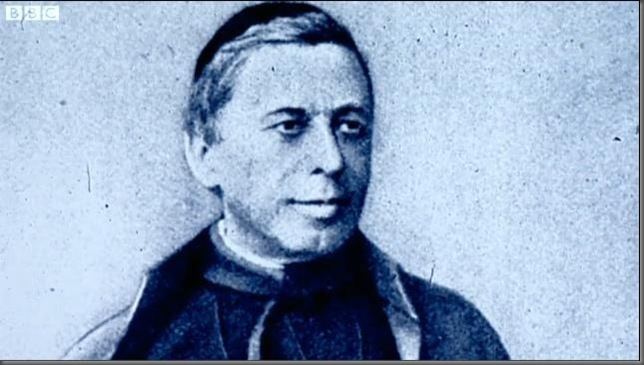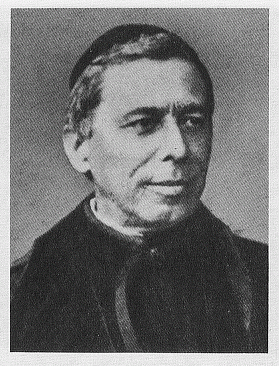Role Astronomer | Name Angelo Secchi Nationality Italian | |
 | ||
Notable awards Legion d'honneur, France Died February 26, 1878, Rome, Italy Parents Antonio Secchi, Luise Belgieri | ||
Angelo secchi live percussionist showreel
Fr. Pietro Angelo Secchi SJ ([ˈpjɛːtro ˈandʒelo ˈsekki]; 29 June 1818 – 26 February 1878) was an Italian astronomer. He was Director of the Observatory at the Pontifical Gregorian University (then called the Roman College) for 28 years. He was a pioneer in astronomical spectroscopy, and was one of the first scientists to state authoritatively that the Sun is a star.
Contents
- Angelo secchi live percussionist showreel
- RSotCC Ep 1 Fr Angelo Secchi SJ Jesuit Astrophysicist
- Biography
- Astronomical works
- Other scientific and technical work
- Heritage
- Works incomplete
- References

RSotCC Ep. 1: Fr. Angelo Secchi S.J., Jesuit Astrophysicist
Biography

Secchi was born in Reggio Emilia, where he studied at the Jesuit gymnasium. At the age of 16, he entered the Jesuit Order in Rome. He continued his studies at the Roman College, and demonstrated great scientific ability. In 1839, he was appointed tutor of mathematics and physics at the College. In 1841, he became Professor of Physics at the Jesuit College in Loreto. In 1844, he began theological studies in Rome, and was ordained a priest on 12 September 1847. In 1848, due to the Roman Revolution, the Jesuits had to leave Rome. Fr. Secchi spent the next two years in the United Kingdom at Stonyhurst College, and the United States, where he taught for a time at Georgetown University in Washington, DC. He also took his doctoral examination in theology there.

During his stay in America, he met Commander Matthew Fontaine Maury, the first Director of the United States Naval Observatory in Washington. He studied with Maury and corresponded with him for many years.

He returned to Rome in 1850. On the recommendation of his late colleague Francesco de Vico, he became head of the Observatory of the College at age 32. In 1853, under his direction, the crumbling Observatory was relocated to a new facility on top of the Sant'Ignazio Church (the chapel of the College). Secchi served as Director until his death.
His position was challenged after 1870, when the remnant of the Papal States around Rome was taken over by the Kingdom of Italy. In 1873, the College was declared property of the Italian government. When the government moved to take over the Observatory as well, Secchi protested vigorously, and threatened to leave the Observatory for one of several positions offered to him by foreign observatories. He was offered important scientific positions and political dignities by the government, but refused to pledge allegiance to the Kingdom in place of the Pope. The royal government did not dare to interfere with him, and he continued as Director.

He died in 1878 at age 59, in Rome.
Astronomical works

Secchi made contributions to many areas of astronomy.
Secchi was especially interested in the Sun, which he observed continually throughout his career.
However, his main area of interest was astronomical spectroscopy. He invented the heliospectrograph, star spectrograph, and telespectroscope. He showed that certain absorption lines in the spectrum of the Sun were caused by absorption in the Earth's atmosphere.
Starting in 1863, he began collecting the spectra of stars, accumulating some 4,000 stellar spectrograms. Through analysis of this data, he discovered that the stars come in a limited number of distinct types and subtypes, which could be distinguished by their different spectral patterns. From this concept, he developed the first system of stellar classification: the five Secchi classes. While his system was superseded by the Harvard system, he still stands as discoverer of the principle of stellar classification, which is a fundamental element of astrophysics. His recognition of molecular bands of carbon radicals in the spectra of some stars made him the discoverer of carbon stars, which made one of his spectral classes.
Other scientific and technical work
Secchi was active in oceanography, meteorology, and physics, as well as astronomy.
He invented the Secchi disk, which is used to measure water transparency in oceans, lakes and fish farms. He studied the climate of Rome and invented a "Meteorograph" for the convenient recording of several categories of weather data. He also studied the aurora borealis, the effects of lightning, and the cause of hail. He organized the systematic monitoring of the Earth's magnetic field, and in 1858 established a Magnetic Observatory in Rome.
Secchi also performed related technical works for the Papal government, such as overseeing placement of sundials and repair or installation of municipal water systems. In 1854-1855, he supervised an exact survey of the Appian Way in Rome. This survey was later used in the topographic mapping of Italy. He supervised construction of lighthouses for the ports of the Papal States. In 1858, he traveled to France and Germany to procure the necessary projection lenses.
Heritage
The lunar crater Secchi and the Martian crater Secchi are both named after him, as is a main belt asteroid, 4705 Secchi.
The two STEREO (Solar TErrestrial RElations Observatory) spacecraft each carry an instrument package called SECCHI (Sun Earth Connection Coronal and Heliospheric Investigation).
Works (incomplete)
During his career, Fr. Secchi published about 730 papers in scientific journals. He also published a number of books.
